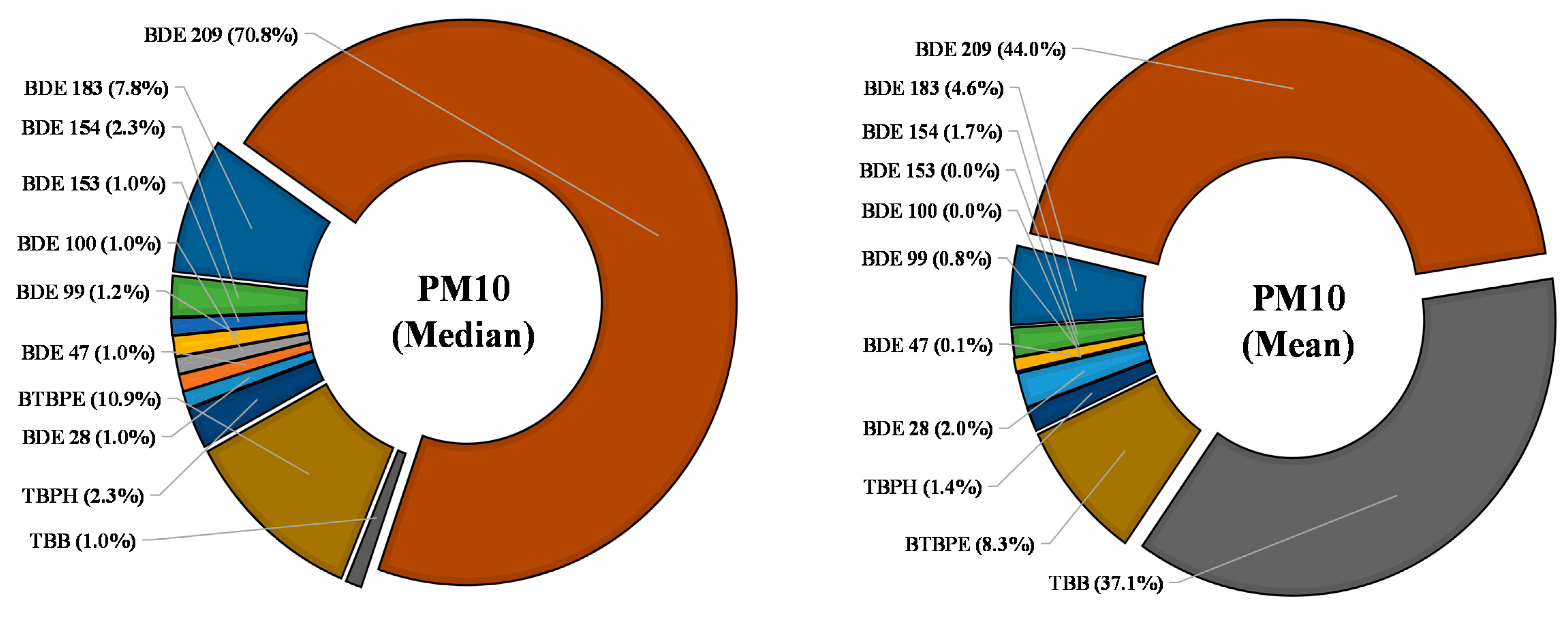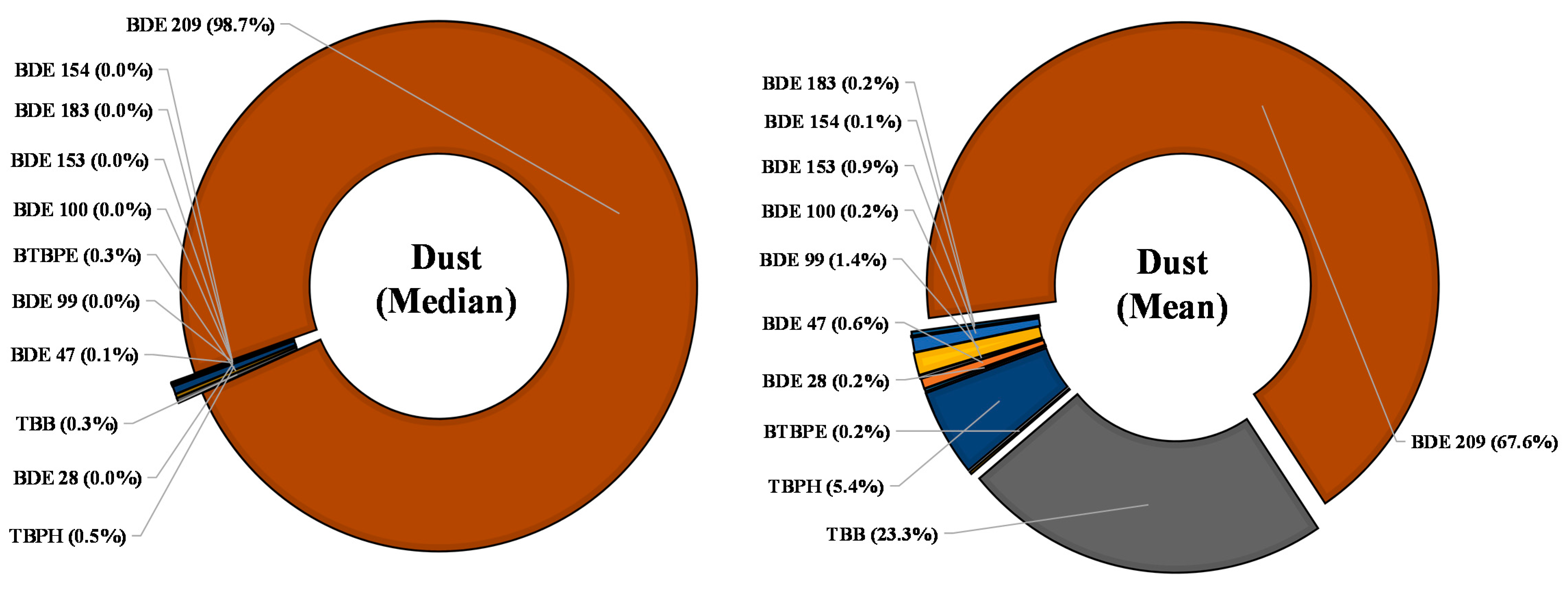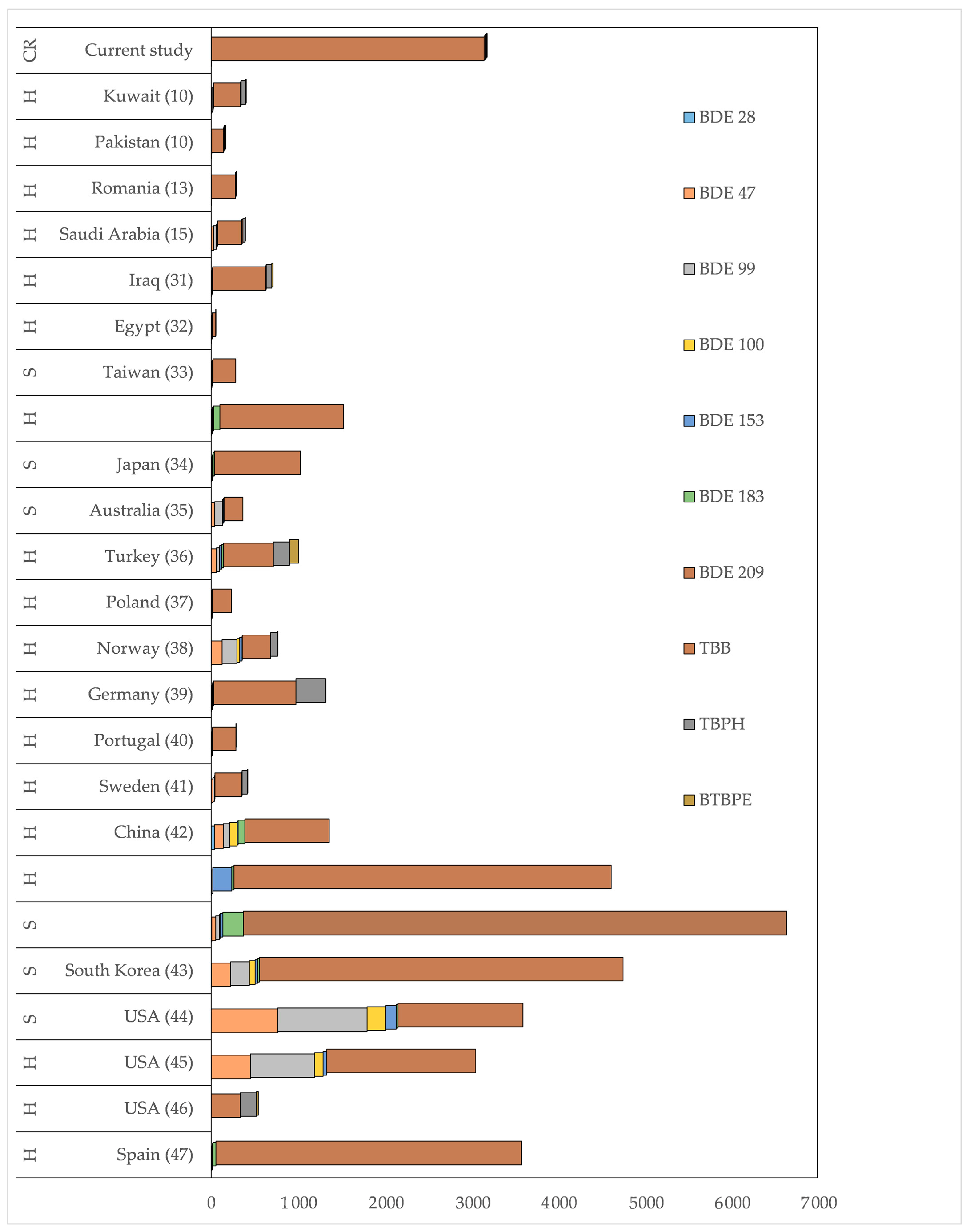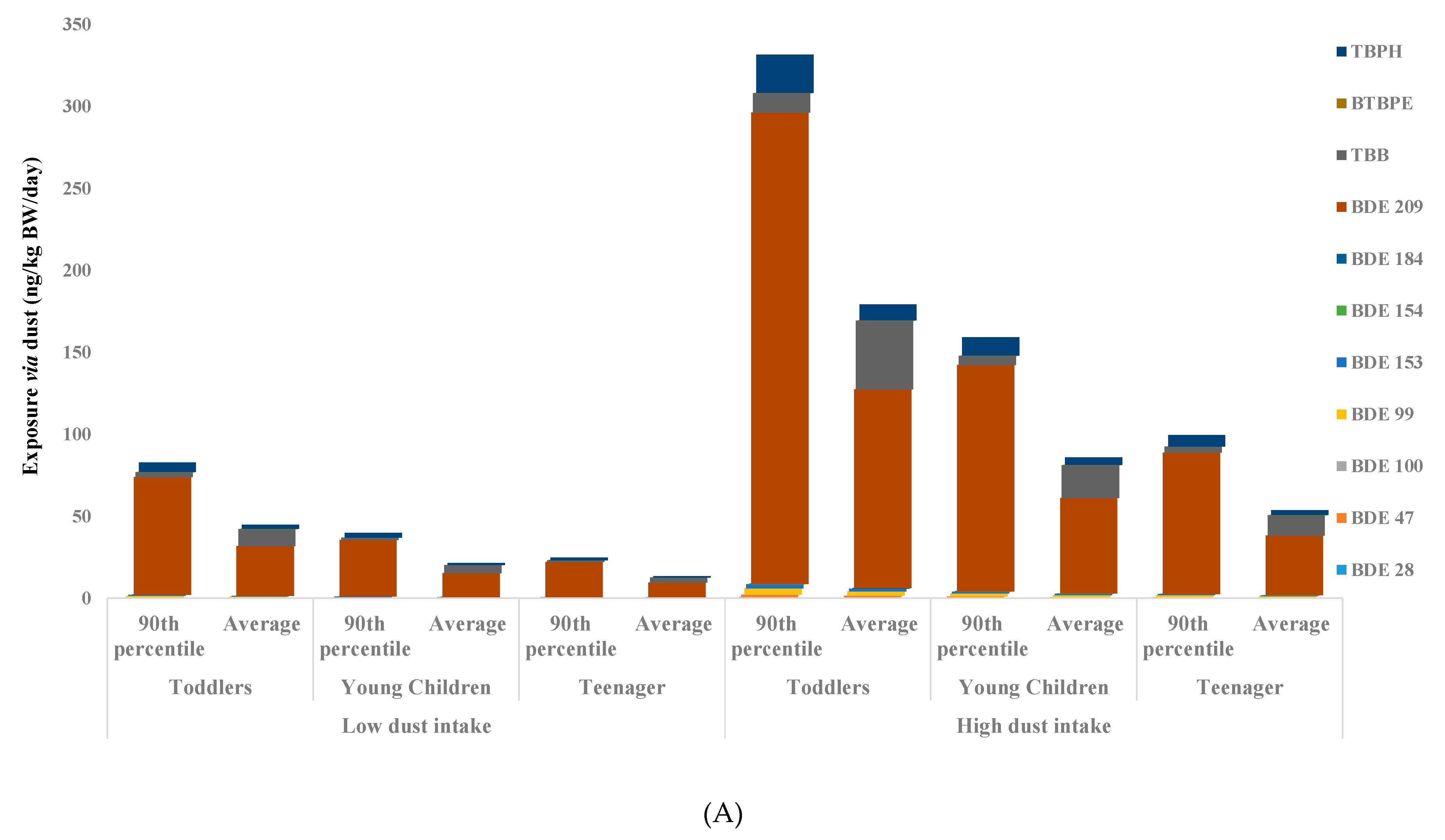Brominated Flame Retardants in Children’s Room: Concentration, Composition, and Health Risk Assessment
Abstract
1. Introduction
2. Materials and Methods
2.1. Chemicals and Solvents
2.2. Sampling
2.3. Sample Preparation and Quantitative Analysis
2.4. Quality Assurance & Quality Control (QA/QC)
2.5. Human Risk Assessment Calculations
3. Results
3.1. Levels and Profile of BFRs in Indoor Dust and PM10 from Children’s Rooms
3.1.1. Particulate Matter 10 (PM10)
3.1.2. Floor Dust
3.2. Comparison with Literature Data
3.3. Human Risk Assessment
4. Conclusions
Supplementary Materials
Author Contributions
Funding
Informed Consent Statement
Data Availability Statement
Acknowledgments
Conflicts of Interest
References
- Covaci, A.; Harrad, S.; Abdallah, M.A.-E.; Ali, N.; Law, R.J.; Herzke, D.; De Wit, C.A. Novel brominated flame retardants: A review of their analysis, environmental fate and behaviour. Environ. Int. 2011, 37, 532–556. [Google Scholar] [CrossRef] [PubMed]
- Shaw, S.D.; Blum, A.; Weber, R.; Kannan, K.; Rich, D.; Lucas, D.; Koshland, C.P.; Dobraca, D.; Hanson, S.; Birnbaum, L.S. Halogenated flame retardants: Do the fire safety benefits justify the risks? Rev. Environ. Health 2010, 25, 216–305. [Google Scholar] [CrossRef]
- Chao, H.-R.; Wang, S.-L.; Lee, W.-J.; Wang, Y.-F.; Päpke, O. Levels of polybrominated diphenyl ethers (PBDEs) in breast milk from central Taiwan and their relation to infant birth outcome and maternal menstruation effects. Environ. Int. 2007, 33, 239–245. [Google Scholar] [CrossRef]
- Darnerud, P.O. Brominated flame retardants as possible endocrine disrupters. Int. J. Androl. 2008, 31, 152–160. [Google Scholar] [CrossRef] [PubMed]
- Main, K.M.; Kiviranta, H.; Virtanen, H.E.; Sundqvist, E.; Tuomisto, J.T.; Tuomisto, J.; Vartiainen, T.; Skakkebæk, N.E.; Toppari, J. Flame Retardants in Placenta and Breast Milk and Cryptorchidism in Newborn Boys. Environ. Health Perspect. 2007, 115, 1519–1526. [Google Scholar] [CrossRef]
- European Court of Justice. 2008. Cases C–14/06 and C–295/06, Judgement of the Court, 1 April 2008, Directive 2002/95/EC and Commission Decision 2005/717/EC. Available online: https://lawthek.eu/detail/5f3d7eb4-10f9-48ec-b930-5ba804381f3a/en/SINGLE (accessed on 20 April 2021).
- Stockholm Convention Text and Annexes as Amended in 2009. Available online: http://chm.pops.int/Portals/0/sc10/files/a/stockholm_convention_text_e.pdf (accessed on 20 April 2021).
- Ali, N.; Shahzad, K.; Rashid, M.I.; Shen, H.; Ismail, I.M.I.; Eqani, S.A.M.A.S. Currently used organophosphate and brominated flame retardants in the environment of China and other developing countries (2000–2016). Environ. Sci. Pollut. Res. 2017, 24, 18721–18741. [Google Scholar] [CrossRef] [PubMed]
- Wei, G.-L.; Li, D.-Q.; Zhuo, M.-N.; Liao, Y.-S.; Xie, Z.-Y.; Guo, T.-L.; Li, J.-J.; Zhang, S.-Y.; Liang, Z.-Q. Organophosphorus flame retardants and plasticizers: Sources, occurrence, toxicity and human exposure. Environ. Pollut. 2015, 196, 29–46. [Google Scholar] [CrossRef]
- Ali, N.; Ali, L.; Mehdi, T.; Dirtu, A.C.; Al-Shammari, F.; Neels, H.; Covaci, A. Levels and profiles of organochlorines and flame retardants in car and house dust from Kuwait and Pakistan: Implication for human exposure via dust ingestion. Environ. Int. 2013, 55, 62–70. [Google Scholar] [CrossRef]
- Ali, N.; Malik, R.N.; Mehdi, T.; Eqani, S.A.M.A.S.; Javeed, A.; Neels, H.; Covaci, A. Organohalogenated contaminants (OHCs) in the serum and hair of pet cats and dogs: Biosentinels of indoor pollution. Sci. Total Environ. 2013, 449, 29–36. [Google Scholar] [CrossRef]
- Zheng, J.; Luo, X.-J.; Yuan, J.-G.; Wang, J.; Wang, Y.-T.; Chen, S.-J.; Mai, B.-X.; Yang, Z.-Y. Levels and sources of brominated flame retardants in human hair from urban, e-waste, and rural areas in South China. Environ. Pollut. 2011, 159, 3706–3713. [Google Scholar] [CrossRef]
- Dirtu, A.C.; Ali, N.; Eede, N.V.D.; Neels, H.; Covaci, A. Country specific comparison for profile of chlorinated, brominated and phosphate organic contaminants in indoor dust. Case study for Eastern Romania, 2010. Environ. Int. 2012, 49, 1–8. [Google Scholar] [CrossRef]
- Johnson, P.I.; Stapleton, H.M.; Sjodin, A.; Meeker, J.D. 2010. Relationships between polybrominated diphenyl ether concen-trations in house dust and serum. Environ. Sci. Technol. 2010, 44, 5627–5632. [Google Scholar] [CrossRef]
- Ali, N.; Eqani, S.A.M.A.S.; Ismail, I.M.I.; Malarvannan, G.; Kadi, M.W.; Albar, H.M.S.; Rehan, M.; Covaci, A. Brominated and organophosphate flame retardants in indoor dust of Jeddah, Kingdom of Saudi Arabia: Implications for human exposure. Sci. Total Environ. 2016, 569–570, 269–277. [Google Scholar] [CrossRef] [PubMed]
- Ali, N.; Ismail, I.M.; Kadi, M.W.; Albar, H.M. Currently used organophosphate flame retardants deter-mined in the settled dust of masjids and hotels of Saudi Arabia, a new insight into human health implications of dust exposure. Environ. Sci. Process. Impacts 2018, 20, 798–805. [Google Scholar] [CrossRef] [PubMed]
- Butte, W.; Heinzow, B. Pollutants in house dust as indicators of indoor contamination. Rev. Environ. Contam. Toxicol. 2002, 175, 1–46. [Google Scholar]
- Malliari, E.; Kalantzi, O.I. Children’s exposure to brominated flame retardants in indoor environments-a re-view. Environ. Int. 2017, 108, 146–169. [Google Scholar] [CrossRef] [PubMed]
- Mercier, F.; Glorennec, P.; Thomas, O.; Le Bot, B. Organic Contamination of Settled House Dust, A Review for Exposure Assessment Purposes. Environ. Sci. Technol. 2011, 45, 6716–6727. [Google Scholar] [CrossRef]
- Ali, N. Polycyclic aromatic hydrocarbons (PAHs) in indoor air and dust samples of different Saudi microenvi-ronments; health and carcinogenic risk assessment for the general population. Sci. Total Environ. 2019, 696, 133995. [Google Scholar] [CrossRef]
- Doyi, I.; Isley, C.F.; Soltani, N.S.; Taylor, M.P. Human exposure and risk associated with trace element concentrations in indoor dust from Australian homes. Environ. Int. 2019, 133, 105125. [Google Scholar] [CrossRef]
- USEPA. Process for Conducting Probabilistic Risk Assessment. In Risk Assessment Guidance for Superfund: Volume III Part A.; US Environmental Protection Agency: Washington, DC, USA, 2001. [Google Scholar]
- Australian Exposure Factor Guidance Document, Guidelines for Assessing Human Health Risks from Environmental Haz-ards. Department of Health. Available online: https://www.health.gov.au/internet/main/publishing.nsf/content/A12B57E41EC9F326CA257BF0001F9E7D/$File/Aust-Exposure-Factor-Guide.pdf (accessed on 1 February 2021).
- EPA USA. Exposure Factors Handbook 2011 Edition (Final Report); US Environmental Protection Agency: Washington, DC, USA, 2011; EPA/600/R-09/052F.
- World Health Organization. Ambient Air Pollution: A Global Assessment of Exposure and Burden of Disease. Available online: https://apps.who.int/iris/bitstream/handle/10665/250141/9789241511353-eng.pdf?sequence=1 (accessed on 8 April 2021).
- McConnell, R.; Islam, T.; Shankardass, K.; Jerrett, M.; Lurmann, F.; Gilliland, F.; Gauderman, J.; Avol, E.; Künzli, N.; Yao, L.; et al. Childhood incident asthma and traffic-related air pollution at home and school. Environ. Health Perspect. 2010, 118, 1021–1026. [Google Scholar] [CrossRef]
- Brook, R.D.; Rajagopalan, S.; Pope, C.A., III.; Brook, J.R.; Bhatnagar, A.; Diez-Roux, A.V.; Holguin, F.; Hong, Y.; Luepker, R.V.; Mittleman, M.A.; et al. Particulate matter air pollution and cardiovascular disease: An update to the scientific statement from the American Heart Association. Circulation 2010, 121, 2331–2378. [Google Scholar] [CrossRef]
- Calderón-Garcidueñas, L.; Mora-Tiscareño, A.; Ontiveros, E.; Gómez-Garza, G.; Barragán-Mejía, G.; Broadway, J.; Chapman, S.; Valencia-Salazar, G.; Jewells, V.; Maronpot, R.R.; et al. Air pollution, cognitive deficits and brain abnormalities: A pilot study with children and dogs. Brain Cogn. 2008, 68, 117–127. [Google Scholar] [CrossRef]
- Sharkey, M.; Harrad, S.; Abdallah, M.A.E.; Drage, D.S.; Berresheim, H. Phasing-out of legacy brominated flame retardants: The UNEP Stockholm Convention and other legislative action worldwide. Environ. Int. 2020, 144, 106041. [Google Scholar] [CrossRef]
- Great Lake Solutions, 2010. DP-45TM. Available online: http://greatlakes.com/ (accessed on 10 March 2021).
- Al-Omran, L.S.; Harrad, S. Distribution pattern of legacy and “novel” brominated flame retardants in different particle size fractions of indoor dust in Birmingham, United Kingdom. Chemosphere 2016, 157, 124–131. [Google Scholar] [CrossRef]
- Hassan, Y.; Shoeib, T. Levels of polybrominated diphenyl ethers and novel flame retardants in microenvi-ronment dust from Egypt: An assessment of human exposure. Sci. Total Environ. 2015, 505, 47–55. [Google Scholar] [CrossRef] [PubMed]
- Gou, Y.-Y.; Que, D.E.; Chuang, C.-Y.; Chao, H.-R.; Shy, C.-G.; Hsu, Y.-C.; Lin, C.-W.; Chuang, K.P.; Tsai, C.-C.; Tayo, L.L. Dust levels of polybrominated diphenyl ethers (PBDEs) and polybrominated dibenzo-p-dioxins/furans (PBDD/Fs) in the Taiwanese elementary school classrooms: Assessment of the risk to school-age children. Sci. Total Environ. 2016, 572, 734–741. [Google Scholar] [CrossRef]
- Mizouchi, S.; Ichiba, M.; Takigami, H.; Kajiwara, N.; Takamuku, T.; Miyajima, T.; Kodama, H.; Someya, T.; Ueno, D. Exposure assessment of organophosphorus and organobromine flame retardants via indoor dust from elementary schools and domestic houses. Chemosphere 2015, 123, 17–25. [Google Scholar] [CrossRef]
- Toms, L.-M.L.; Mazaheri, M.; Brommer, S.; Clifford, S.; Drage, D.; Mueller, J.F.; Thai, P.; Harrad, S.; Morawska, L.; Harden, F. Polybrominated diphenyl ethers (PBDEs) in dust from primary schools in South East Queensland, Australia. Environ. Res. 2015, 142, 135–140. [Google Scholar] [CrossRef] [PubMed]
- Kurt-Karakus, P.B.; Alegria, H.; Jantunen, L.; Birgul, A.; Topcu, A.; Jones, K.C.; Turgut, C. Polybrominated diphenyl ethers (PBDEs) and alternative flame retardants (NFRs) in indoor and outdoor air and indoor dust from Is-tanbul-Turkey: Levels and an assessment of human exposure. Atmos. Pollut. Res. 2017, 8, 801–815. [Google Scholar] [CrossRef]
- Król, S.; Namiesnik, J.; Zabiegała, B. Occurrence and levels of polybrominated diphenyl ethers (PBDEs) in house dust and hair samples from Northern Poland; an assessment of human exposure. Chemosphere 2014, 110, 91–96. [Google Scholar] [CrossRef]
- Cequier, E.; Ionas, A.C.; Covaci, A.; Marcé, R.M.; Becher, G.; Thomsen, C. Occurrence of a Broad Range of Legacy and Emerging Flame Retardants in Indoor Environments in Norway. Environ. Sci. Technol. 2014, 48, 6827–6835. [Google Scholar] [CrossRef]
- Fromme, H.; Hilger, B.; Kopp, E.; Miserok, M.; Völkel, W. Polybrominated diphenyl ethers (PBDEs), hexa-bromocyclododecane (HBCD) and “novel” brominated flame retardants in house dust in Germany. Environ. Int. 2014, 64, 61–68. [Google Scholar] [CrossRef]
- Coelho, S.D.; Sousa, A.C.; Isobe, T.; Kim, J.-W.; Kunisue, T.; Nogueira, A.J.; Tanabe, S. Brominated, chlorinated and phosphate organic contaminants in house dust from Portugal. Sci. Total Environ. 2016, 569, 442–449. [Google Scholar] [CrossRef]
- Sahlström, L.M.; Sellström, U.; de Wit, C.A.; Lignell, S.; Darnerud, P.O. Estimated intakes of brominated flame retardants via diet and dust compared to internal concentrations in a Swedish mother—toddler cohort. Int. J. Hyg. Environ. Health 2015, 218, 422–432. [Google Scholar] [CrossRef] [PubMed]
- Kang, Y.; Wang, H.S.; Cheung, K.C.; Wong, M.H. Polybrominated diphenyl ethers (PBDEs) in indoor dust and human hair. Atmos. Environ. 2011, 45, 2386–2393. [Google Scholar] [CrossRef]
- Lim, Y.-W.; Kim, H.-H.; Lee, C.-S.; Shin, D.C.; Chang, Y.-S.; Yang, J.-Y. Exposure assessment and health risk of poly-brominated diphenyl ether (PBDE) flame retardants in the indoor environment of elementary school students in Korea. Sci. Total Environ. 2014, 470–471, 1376–1389. [Google Scholar] [CrossRef] [PubMed]
- Darrow, L.A.; Jacobson, M.H.; Preston, E.V.; Lee, G.E.; Panuwet, P.; Hunter Jr, R.E.; Marder, M.E.; Marcus, M.; Barr, D.B. Predictors of serum polybrominated diphenyl ether (PBDE) concentrations among children aged 1–5 years. Environ. Sci. Technol. 2017, 51, 645–654. [Google Scholar] [CrossRef]
- Stapleton, H.M.; Misenheimer, J.; Hoffman, K.; Webster, T.F. Flame retardant associations between children’s handwipes and house dust. Chemosphere 2014, 116, 54–60. [Google Scholar] [CrossRef] [PubMed]
- Brown, F.R.; Whitehead, T.P.; Park, J.-S.; Metayer, C.; Petreas, M.X. Levels of non-polybrominated diphenyl ether brominated flame retardants in residential house dust samples and fire station dust samples in California. Environ. Res. 2014, 135, 9–14. [Google Scholar] [CrossRef]
- Cristale, J.; Hurtado, A.; Gómez-Canela, C.; Lacorte, S. Occurrence and sources of brominated and organo-phosphorus flame retardants in dust from different indoor environments in Barcelona, Spain. Environ. Res. 2016, 149, 66–76. [Google Scholar] [CrossRef]
- Allen, J.G.; McClean, M.D.; Stapleton, H.M.; Nelson, J.W.; Webster, T.F. Personal Exposure to Polybrominated Diphenyl Ethers (PBDEs) in Residential Indoor Air. Environ. Sci. Technol. 2007, 41, 4574–4579. [Google Scholar] [CrossRef]
- Johnson-Restrepo, B.; Kannan, K. An assessment of sources and pathways of human exposure to polybrominated diphenyl ethers in the United States. Chemosphere 2009, 76, 542–548. [Google Scholar] [CrossRef] [PubMed]
- de Wit, C.A.; Björklund, J.A.; Thuresson, K. Tri-decabrominated diphenyl ethers and hexabromocyclododecane in indoor air and dust from Stockholm microenvironments 2: Indoor sources and human exposure. Environ. Int. 2012, 39, 141–147. [Google Scholar] [CrossRef] [PubMed]
- Thuresson, K.; Björklund, J.A.; de Wit, C.A. Tri-decabrominated diphenyl ethers and hexabromocyclododecane in indoor air and dust from Stockholm microenvironments 1: Levels and profiles. Sci. Total Environ. 2012, 414, 713–721. [Google Scholar] [CrossRef] [PubMed]
- Gevao, B.; Al-Bahloul, M.; Al-Ghadban, A.N.; Ali, L.; Al-Omair, A.; Helaleh, M.; Al-Matrouk, K.; Zafar, J. Polybrominated diphenyl ethers in indoor air in Kuwait: Implications for human exposure. Atmos. Environ. 2006, 40, 1419–1426. [Google Scholar] [CrossRef]
- Wu, Q.; Baek, S.-Y.; Fang, M.; Chang, Y.-S. Distribution and fate of polybrominated diphenyl ethers in indoor environments of elementary schools. Indoor Air 2010, 20, 263–270. [Google Scholar] [CrossRef]
- Harrad, S.; Hazrati, S.; Ibarra, C. Concentrations of Polychlorinated Biphenyls in Indoor Air and Polybrominated Diphenyl Ethers in Indoor Air and Dust in Birmingham, United Kingdom: Implications for Human Exposure. Environ. Sci. Technol. 2006, 40, 4633–4638. [Google Scholar] [CrossRef]
- Wang, W.; Zheng, J.; Chan, C.-Y.; Huang, M.-J.; Cheung, K.C.; Wong, M.H. Health risk assessment of exposure to polybrominated diphenyl ethers (PBDEs) contained in residential air particulate and dust in Guangzhou and Hong Kong. Atmos. Environ. 2014, 89, 786–796. [Google Scholar] [CrossRef]
- Shy, C.-G.; Hsu, Y.-C.; Shih, S.-I.; Chuang, K.P.; Lin, C.-W.; Wu, C.-W.; Chuang, C.-Y.; Chao, H.-R. Indoor Level of Polybrominated Diphenyl Ethers in the Home Environment and Assessment of Human Health Risks. Aerosol Air Qual. Res. 2015, 15, 1494–1505. [Google Scholar] [CrossRef]
- Li, Z.-H.; Liu, X.-Y.; Wang, N.; Chen, J.-S.; Chen, Y.-H.; Huang, J.-T.; Su, C.-H.; Xie, F.; Yu, B.; Chen, D.-J. Effects of Decabrominated Diphenyl Ether (PBDE-209) in Regulation of Growth and Apoptosis of Breast, Ovarian, and Cervical Cancer Cells. Environ. Health Perspect. 2012, 120, 541–546. [Google Scholar] [CrossRef]
- ATSDR, 2017; Public Health Statement Polybrominated Diphenyl Ethers (PBDEs). Available online: https://www.atsdr.cdc.gov/ToxProfiles/tp207-c1-b.pdf (accessed on 19 April 2021).
- Kim, Y.R.; Harden, F.; Toms, L.-M.L.; Norman, R.E. Health consequences of exposure to brominated flame retardants: A systematic review. Chemosphere 2014, 106, 1–19. [Google Scholar] [CrossRef] [PubMed]
- Lyche, J.L.; Rosseland, C.; Berge, G.; Polder, A. Human health risk associated with brominated flame-retardants (BFRs). Environ. Int. 2015, 74, 170–180. [Google Scholar] [CrossRef]
- Sahlström, L.M.; Sellström, U.; de Wit, C.A.; Lignell, S.; Darnerud, P.O. Brominated flame retardants in matched serum samples from Swedish first-time mothers and their toddlers. Environ. Sci. Technol. 2014, 48, 7584–7592. [Google Scholar] [CrossRef] [PubMed]
- Xiong, P.; Yan, X.; Zhu, Q.; Qu, G.; Shi, J.; Liao, C.; Jiang, G. A Review of Environmental Occurrence, Fate, and Toxicity of Novel Brominated Flame Retardants. Environ. Sci. Technol. 2019, 53, 13551–13569. [Google Scholar] [CrossRef]
- Zhao, X.; Chen, T.; Yang, B.; Wang, D.; Sun, W.; Wang, Y.; Yang, X.; Wen, S.; Li, J.; Shi, Z. Serum levels of novel brominated flame retardants (NBFRs) in residents of a major BFR-producing region: Occurrence, impact factors and the relationship to thyroid and liver function. Ecotoxicol. Environ. Saf. 2021, 208, 111467. [Google Scholar] [CrossRef] [PubMed]





| Analytes | Dust (ng/g) | Air (pg/m3) | ||
|---|---|---|---|---|
| Mean ± Standard Deviation | Median (Min–Max) | Mean ± Standard Deviation | Median (Min–Max) | |
| BDE 28 | 15 ± 18 | <0.2 (<0.2–95) | 5 ± 7 | <1 (<1–50) |
| BDE 47 | 65 ± 150 | 2 (<0.2–500) | 1 ± 1 | <1 (<1–3) |
| BDE 100 | 20 ± 60 | <0.2 (<0.2–230) | 0 ± 0 | <1 |
| BDE 99 | 145 ± 375 | <0.2 (<0.2–1650) | 2 ± 3 | 2 (<1–15) |
| BDE 153 | 95 ± 290 | <0.2 (<0.2–1380) | 0 ± 0 | <1 |
| BDE 154 | 10 ± 25 | <0.2 (<0.2–115) | 5 ± 5 | 2 (<1–20) |
| BDE 183 | 25 ± 100 | <0.2 (<0.2–485) | 12 ± 15 | 8 (<1–45) |
| BDE 209 | 7270 ± 12,880 | 3150 (<2–60,800) | 120 ± 150 | 75 (<10–700) |
| TBB | 2500 ± 1140 | 10 (<2–56,020) | 100 ± 495 | <2 (<2–2500) |
| BTBPE | 17 ± 65 | 8 (<1–320) | 20 ± 25 | 11 (<2–90) |
| TBPH | 580 ± 1520 | 15 (<2–6530) | 4 ± 5 | 2 (<2–15) |
| ∑BFRs | 10,900 ± 18,300 | 3950 (1300–61,500) | 300 ± 500 | 180 (<2–2550) |
| PM10 | 75 ± 62 | 58 (15–275) | ||
| Non-Carcinogenic | CDI (Ingestion-nca) | CDI (Inhalation-nca) | CDI (Dermal-nca) | HQ-Ingestion | HQ-Inhalation | HQ-Dermal | HI |
|---|---|---|---|---|---|---|---|
| BDE-28 | 6.39 × 10−7 | 2.54 × 10−10 | 7.67 × 10−8 | 6.39 × 10−3 | 2.54 × 10−6 | 7.67 × 10−4 | 7.16 × 10−3 |
| BDE-47 | 1.01 × 10−6 | 0.00 | 1.21 × 10−7 | 1.01 × 10−2 | 0.00 | 1.21 × 10−3 | 1.13 × 10−2 |
| BDE-100 | 1.21 × 10−7 | 0.00 | 1.46 × 10−8 | 1.21 × 10−3 | 0.00 | 1.46 × 10−4 | 1.36 × 10−3 |
| BDE-99 | 2.87 × 10−6 | 2.24 × 10−11 | 3.45 × 10−7 | 2.87 × 10−2 | 2.24 × 10−7 | 3.45 × 10−3 | 3.22 × 10−2 |
| BDE-153 | 1.92 × 10−6 | 0.00 | 2.31 × 10−7 | 9.61 × 10−3 | 0.00 | 1.15 × 10−3 | 1.08 × 10−2 |
| BDE-154 | 8.09 × 10−8 | 7.07 × 10−11 | 9.70 × 10−9 | 4.04 × 10−4 | 3.54 × 10−7 | 4.85 × 10−5 | 4.53 × 10−4 |
| BDE-183 | 3.16 × 10−8 | 1.86 × 10−10 | 3.79 × 10−9 | 1.05 × 10−4 | 6.19 × 10−7 | 1.26 × 10−5 | 1.19 × 10−4 |
| BDE-209 | 2.21 × 10−4 | 1.63 × 10−9 | 2.65 × 10−5 | 3.15 × 10−2 | 2.33 × 10−7 | 3.78 × 10−3 | 3.53 × 10−2 |
| TBB | 9.10 × 10−6 | 5.45 × 10−11 | 1.09 × 10−6 | 4.55 × 10−4 | 2.73 × 10−9 | 5.46 × 10−5 | 5.10 × 10−4 |
| BTBPE | 1.87 × 10−7 | 3.27 × 10−10 | 2.25 × 10−8 | 7.70 × 10−7 | 1.35 × 10−9 | 9.24 × 10−8 | 8.64 × 10−7 |
| TBPH | 1.79 × 10−5 | 6.55 × 10−11 | 2.15 × 10−6 | 8.94 × 10−4 | 3.27 × 10−9 | 1.07 × 10−4 | 1.00 × 10−3 |
| Carcinogenic | CDI (Ingestion-ca) | CDI (Inhalation-ca) | CDI (Dermal-ca) | ILRC-Ingestion | ILRC-Inhalation | ILRC-Dermal | ILRC |
| BDE-209 | 2.67 × 10−5 | 3.84 × 10−9 | 2.57 × 10−6 | 1.87 × 10−7 | 1.80 × 10−8 | 2.05 × 10−7 |
Publisher’s Note: MDPI stays neutral with regard to jurisdictional claims in published maps and institutional affiliations. |
© 2021 by the authors. Licensee MDPI, Basel, Switzerland. This article is an open access article distributed under the terms and conditions of the Creative Commons Attribution (CC BY) license (https://creativecommons.org/licenses/by/4.0/).
Share and Cite
Bannan, D.; Ali, N.; Alhakamy, N.A.; Alfaleh, M.A.; Alharbi, W.S.; Rashid, M.I.; Rajeh, N.; Malarvannan, G. Brominated Flame Retardants in Children’s Room: Concentration, Composition, and Health Risk Assessment. Int. J. Environ. Res. Public Health 2021, 18, 6421. https://doi.org/10.3390/ijerph18126421
Bannan D, Ali N, Alhakamy NA, Alfaleh MA, Alharbi WS, Rashid MI, Rajeh N, Malarvannan G. Brominated Flame Retardants in Children’s Room: Concentration, Composition, and Health Risk Assessment. International Journal of Environmental Research and Public Health. 2021; 18(12):6421. https://doi.org/10.3390/ijerph18126421
Chicago/Turabian StyleBannan, Douha, Nadeem Ali, Nabil A. Alhakamy, Mohamed A. Alfaleh, Waleed S. Alharbi, Muhammad Imtiaz Rashid, Nisreen Rajeh, and Govindan Malarvannan. 2021. "Brominated Flame Retardants in Children’s Room: Concentration, Composition, and Health Risk Assessment" International Journal of Environmental Research and Public Health 18, no. 12: 6421. https://doi.org/10.3390/ijerph18126421
APA StyleBannan, D., Ali, N., Alhakamy, N. A., Alfaleh, M. A., Alharbi, W. S., Rashid, M. I., Rajeh, N., & Malarvannan, G. (2021). Brominated Flame Retardants in Children’s Room: Concentration, Composition, and Health Risk Assessment. International Journal of Environmental Research and Public Health, 18(12), 6421. https://doi.org/10.3390/ijerph18126421








